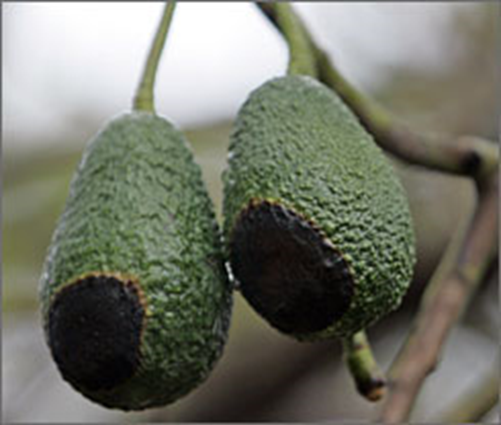- Author: Ben Faber
A great idea from Ed McFadden of Philmore
You can always do something to prevent or correct the Big 4 that seem to strike avocados on a regular basis somewhere in California. Avocados in the back country are right up against areas that can burn easily. A fast fire can send embers into an orchard which can burn through the thick leaves in a slow burn. If it gets up against leaves piled up against the trunk, it can girdle the tree, killing it. The slow burn can continue through the orchard torching the irrigation lines. With a small fire break where the leaves are removed in a small alley, the burn can be slowed or stopped.
Leaves are great for erosion control, for nutrient cycling and disease control, but if they mean increasing potential for fire spread, it's a good idea to remove a little of it. Ed has found that a backpack blower can rapidly remove leaves from around the base of trees and create a narrow fire break that can reduce fire damage to trees.
Avocado orchards are notable for their ability to actually reduce fire hazard and slow major fires as has been shown in fires in San Diego, Ventura and Santa Barbara. This is partly due to running sprinklers during wild fire. But tree loss can still occur, especially when electricity goes down and pumps can't run.
Little rain this year or too much rain this year can always pose a hazard to avocado orchards. This sure seems like a good idea to me. And maybe it's time to start thinking about fire season now.
Photos: Cleared alley and trunk.
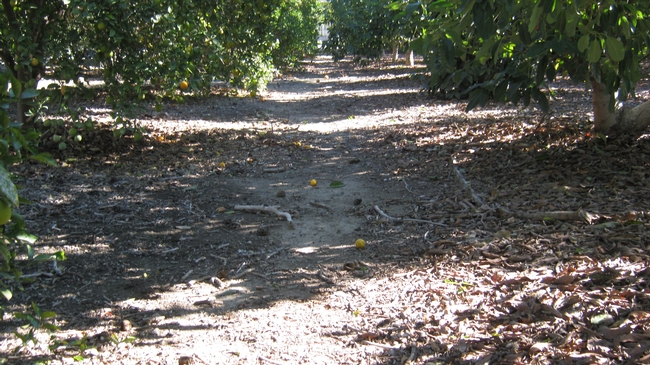
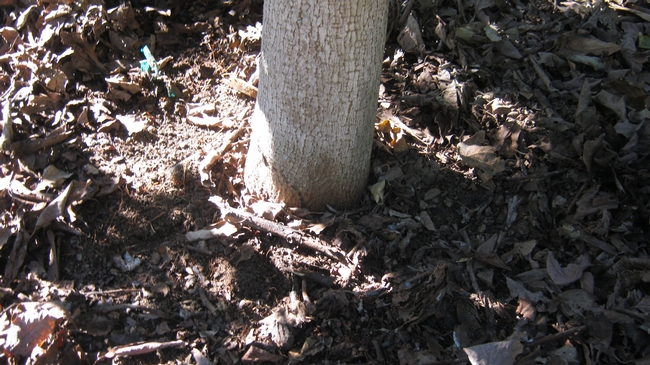
- Author: Ben Faber
Avocado is a tree that has a good ability to respond to fire damage, if it is not too extensive. However, often a tree will recover only to collapse later on in the year or years because of the damage. So a tree may appear to do well and then suddenly collapse. In an orchard setting, fire damage can kill one tree completely, whereas the one just beside it recovers completely. This poses a major problem with irrigation management. How to irrigate the slowly regenerating tree that gradually needs more water, less frequently, next to trees that are recovering at a different rate or not at all. This becomes a management nightmare. Often the result of the difficulty of water management, the remaining trees develop root rot and they eventually die from that and not the original fire damage.
There is a general rule of thumb I have learned and used – when more than 50% of the trees have succumbed, it is best to replace the whole orchard. This is due to the issues of irrigation management and the loss of return from the unused portion of the grove.
So, from a pure economic management aspect, where there is any fire damage, that area should be considered a loss. If you look at your aerial survey and just measure the areas that show fire damage and take that as a proportion of the total planted area, you should be able to assess the extent of the damage incurred in the fire. So measuring the brown areas relative to green should give you a good assessment of the damage incurred in the fire.
It may be possible to nurse back individual trees with a lot of attention and if it's a small enough area, go ahead. But on commercial scale of acres, it often doesn't pay from a management point of view to nurse the orchard to an economic production level.
Fire Information:
http://ceventura.ucanr.edu/Agricultural_Threats/Fire_Information/
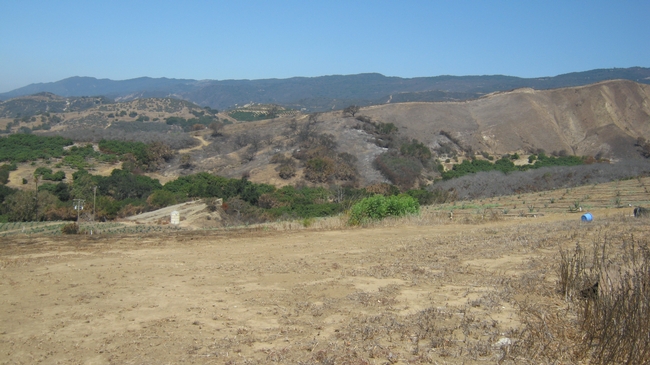
- Author: Ben Faber
The destruction after a fire can be pretty gruesome and sad. Many times, though the fire moves through the orchard so fast that, even though the canopy has turned brown, there is a good chance the trees can come back. It all depends on how much damage has been done to the trunk. If the fire has substantially damaged the base of the trunk, it is unlikely to come back, even if the canopy is still green. That is the saddest thing, because you think you've dodged the bullet, but if the trunk is too damage, the canopy collapses gradually over a few weeks. However, the canopy may look a goner, but if the trunk is still intact, the tree will come back and may still be as productive as before.
The thing to look for at the base of the trunk is the discoloration. If it's black, it's probably not coming back. However, it can come back if after a few weeks you don't see the pencil-sized cankers that indicate that the sap has bubbled to the surface (see photo 1 below). If after a few weeks, the trunk is still clear of those bubbles (photo 2), even though the canopy looks gone, it is quite likely to come back.
It's also possible that the trunk may be damage in just one part of the trunk and not on the rest. In this case, it can also come back. The problem with these ones, is that they may come back and given enough time will be good trees again. But if they haven't recovered enough and there's a sudden heat spell, they may go down suddenly as if they had been burned again. That's the way they will look, like they have been burned again. Given enough time, though the avocado will grow from good areas to cover the poor areas and the tree may be productive again.
Avocados are amazing in their ability to recover. Eucalyptus can do it. But you singe the trunk of a lemon, and good-bye lemon.
Fire Information:
http://ceventura.ucanr.edu/Agricultural_Threats/Fire_Information/
Photo 1 and 2.
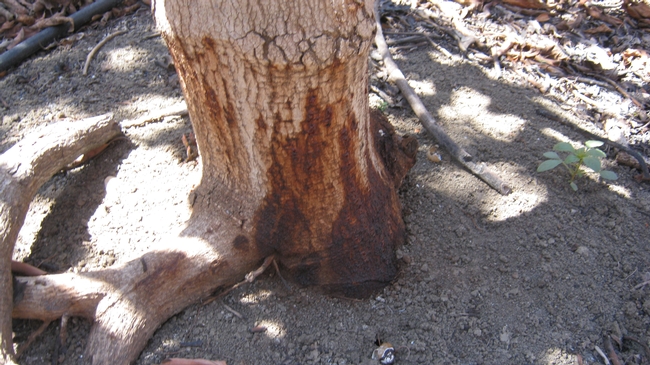
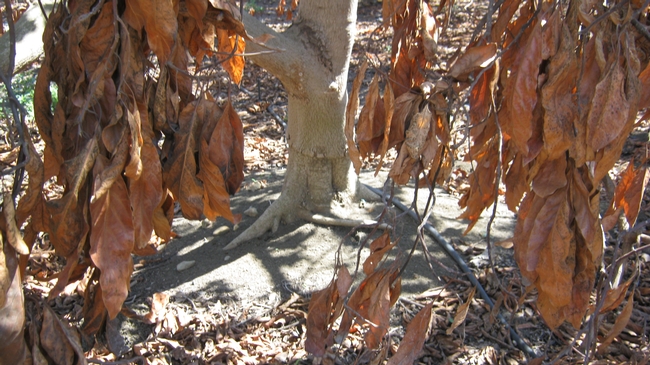
- Author: Ben Faber
The very fact that avocados can be grown in hard to get to places means that the trees are also in areas that are subject to wildfire damage. Recently several hundred acres of avocado burned in the Fillmore/Santa Paula foothills. The fire was fanned by high winds and low humidity. And in spite of being five weeks away from the June 1 weed abatement date, the green hills burned with fury.
Every year there are avocado trees that burn, either through careless attention to early morning fires that pickers build, wildfires or car accidents. A grower needs to be patient and observant to bring the trees back into production.
Although injury to foliage and young growth is visible within a few days of the fire, the full extent of the damage may not be known for several months or possibly the next growing season. In the case of severe injury, die-back may continue to occur for several months after the fire. New growth that occurs after the fire may suddenly collapse the following year when the growth is tested by Santa Ana conditions.
The important rule to follow after a fire is to do nothing - don't prune, don't water, don't fertilize. The avocado has a tremendous ability to come back from fire and frost damage. However, the tree will tell you where it is coming back. It will start pushing growth where the tree is still healthy. It may take 3 to 6 months for this growth to occur.
Delay pruning until the tree clearly shows where it is going to regrow. By waiting, you save the expense of having to return sometime later to remove more wood and also will be able to save the maximum about of tree.
In the meantime, if the tree has been defoliated by the fire, it has lost its ability to transpire water. Watering a tree with no leaves will set up those conditions that are conducive to root rot. Until the tree begins to leaf out, the emitters should be capped or plugged. Then as the tree puts on new growth, shallow, infrequent irrigations should start. This may mean replacing the 10 gph microsprinkler with a 1 gph dripper if only a portion of the orchard has been burned and the rest of the trees need their usual amounts and frequency of water.
An activity the grower can perform is whitewashing. The defoliated tree can be further damaged by sunburn after it has lost its protective cover of leaves. The upper surface of horizontal limbs and the south sides of exposed trunks are the most affected. The whitewash can delay the appearance of new growth, but it does not affect total growth. There is usually no value in applying the whitewash to small limbs.
There are various commercial whitewashes on the market or one can be prepared by mixing 50 pounds of hydrated lime and 100 gallons of water. The easiest to prepare is the cheapest latex paint on the market mixed with water to the extent that it will go through a sprayer.
Avocado trees have a great ability to recover after fire damage. Even trees killed below the bud union will frequently develop into good trees if they are rebudded and given good care. Trees which do not put out vigorous sprouts should be removed. Interplanting avocados would rarely be advisable because of their rapid recovery. Think of fire as an advanced pruning plan.
Fire Information:
http://ceventura.ucanr.edu/Agricultural_Threats/Fire_Information/

- Author: sonia rios
Sonia Rios, Area Subtropical Horticulture Advisor, Riverside & San Diego Counties
Henry Herrera, Forester, California Department of Forestry and Fire Protection (CAL FIRE)
Gary Bender, Subtropical Horticulture Advisor, San Diego County
This is a reposting of a blog from 2015 that is still pertinent today.
Vegetation Weed Management
Vegetation weed management is something CAL FIRE feels strongly about, especially during times of drought. CAL FIRE interprets this type of weed management as a fuel reduction or fuel modification practice which helps growers create defensible space around their habitable structures or groves. Defensible space is a buffer between property (i.e. homes, groves, infrastructure) and plants (i.e. brush, trees, etc.) or other items surrounding the property to be protected that could catch fire and act as fuel.
Defensible space is needed to slow the spread of a wildfire and improves the safety of firefighters defending properties. Defensible space reduces the fire risk and creates space that firefighters can use as a tool to work safely and suppress a wildfire and to defend a structure or other property in the event of a wildfire. Fuel modification/reduction projects include defensible space around structures, fuelbreaks along roads and groves, ridge tops, or around property lines and other fire fuel reduction activities that lessen the risk of wildfires to communities. Fuel reduction projects usually remove cut vegetation from the site either through burning or haul-away methods. Fuel modification projects usually leave the cut vegetation on site in the form of wood chips or scattered material. These types of projects break up the lateral and horizontal vegetative continuity which reduced rates of fire spread, fire intensity, and flame heights which increase firefighter's chances of suppressing fires.
Prunings piled in draws within or around the groves can also be particularly damaging because they are dried vegetation which pose an increased fire danger due to the fact that piles of vegetation can easily ignite and smolder for a long time creating a challenge to firefighters. Vegetation that is piled in draws or other waterways can also obstruct water flow during rain events which could lead to erosion and flooding.
How to Keep our Growers and Groves Safe
Preventative Measures:
These preventive measures can be suggested for groves in areas of high fire hazard are often counter to other measures which might reduce erosion or improve root disease control, so a balance should be strived for (Goodall 1965):
1. Remove all combustible material from around the trunks of the trees for a distance of two to three feet.
2. Prune off low-lying limbs, those that are low enough to accumulate more than the normal inch or so of leaf mulch.
3. Remove from the orchard all broken limbs, deadwood and other combustible debris.
4. Clear brush, trees and other heavy vegetation away from edge of orchard for a distance of at least 50 feet.
5. Do not pile brush or other combustible material in draws or canyons, or around the edges of groves.
6. Apply sprinkler water for as long a period in advance of the fire as possible so as to have everything wet. Water during the fire would obviously be desirable but often is lacking because of lack of pressure or speed of the movement of the fire.
7. Use steel pipe and risers for above ground sprinkler systems.
Growers can also look for other tips on preventive measures on the Cal Fire website: http://calfire.ca.gov/fire_prevention/fire_prevention.php.
After a Fire
It is nearly impossible to determine the extent of damage to the wood of the tree immediately after the fire. The most critical part of the tree is the main trunk. The bark from just above the ground to about two feet high can become hot enough to kill the cambium, the growth layer between the bark and wood. When the cambium is killed, the tree is girdled and will die (Goodall 1965). Suckers will eventually grow from below the graft union of these trees; these suckers can then be grafted to an appropriate variety. However, many trees in the grove may still be alive internally because there was a quick burn through the grove, or the leaves merely died from heat generated by burning surrounding trees, vegetation and mulch (Bender 2012).
According to Bender (2012), fire damaged trees that have leaves that are completely brown do not use water, but there may be trees that have escaped the fire in the irrigation block and these need to be irrigated as soon as possible. The first thing to do is to repair the irrigation system. Risers, sprinklers, pressure regulators and poly-hose on the ground are probably melted and should be replaced as soon as possible. PVC pipe that is buried underground is usually fine, depending on its depth and fire intensity. If part of the trees in the irrigation block are alive and partly damaged, it would probably be best to roll out poly-hose onto the damaged trees and set up a separate irrigation block. As the trees recover and start using water, you can eventually go back to the permanent system.
Trees that are heavily damaged do not use as much water (therefore transpiration is reduced significantly), but their feeder roots need to be watered and short irrigations should occur to replace water evaporating off of the soil surface. Start with a one hour irrigation and monitor the soil closely, irrigating too heavily could lead to the onset of root rot. Do not irrigate damaged trees on its original schedule; a ten hour irrigation will not “force” the trees to grow back sooner, and roots could be easily damaged by lack of oxygen in the lower soil profiles due to water accumulating and the soil becoming saturated.
Every fire is different, so experiences vary. It may take several months to be able to observe whether the bark is killed all the way to the cambium or not. Thus, we recommend against pruning until new growth appears to indicate where the wood is alive. According to Bender (2012), an alternative method which is rather unique to the avocado industry, the burned trees can all be stumped immediately and allowed to re-grow. “Stumping” is a normal practice in the industry when avocado trees have reached such heights that fruit is high off the ground and picking becomes difficult. In many of the groves that were burned, stumping was probably needed anyway; therefore after a burn stumping would be a reasonable alternative for many growers.
Fire damaged trees should be whitewashed on the south side of the limbs. Goodall (1965) also suggests to save expenses, fertilizer and pest control can be postponed for a year or so.
According to Bender (2012), if the goal of the grower is to bring trees back into production as soon as possible, the avocado tree will usually recover production faster if the grower is patient and prunes only the dead wood three months after the fire. Unfortunately, this practice creates a permanent problem in the grove as far as irrigation scheduling and application. Mixing full-grown trees (untouched by the fire) with partially pruned trees (and stumped trees) in an irrigation block means that some trees will be over-watered, or under-watered, depending on their size. Adjustments can be made in the sprinkler sizes, but generally this is an undesirable cultural practice due to every tree needing a different rate of irrigation and can this can also add to labor and equipment costs.
If the goal is to reduce the size of all trees in the irrigation block to a manageable size, then stumping the block immediately after the fire is the best solution. Trees will be out of production for two years and have about 50% production in the third year, and some re-grafting may have to be done, but fertilizing and watering properly is manageable.
A third option could be to scaffold all trees in an irrigation block to 12' in height. This would get rid of a lot of dead wood immediately, and might allow the trees to come back in production faster than the stumping the trees.
It is helpful for growers to know the value, for insurance purposes, of trees that are lost due to fire. Determining the value of a tree in an orchard is not a simple matter because one must take into account the income lost if the tree had been producing, as well as the costs of planting and maintaining the new tree. Also, the income from the new tree, once it comes into bearing, helps to defray the costs involved in bringing the tree to maturity. Examples can be seen here at the UCCE website: http://ceventura.ucanr.edu/Agricultural_Threats/Fire_Information/. Assessing tree loss can be calculated at the UC DAvis Ag Econoimics website: https://coststudies.ucdavis.edu/en/tree-vine-loss/
Record-low rainfall, extreme heat and a statewide drought has caused a significant increase in wildfires and a need for Californians to participate in fire-prevention tactics, including growers. According to CAL FIRE, in order to prevent wildfires and property damage, homeowners are asked to maintain “defensible space” around their house and groves year round and not use powered equipment outdoors when it's hot, dry or windy. Wildfire prevention such as defensible space, keeping properties cleared of dried vegetation, and public education is the best long term solution.
Photo 1: An inmate firefighter crew battles a fire in an avocado grove outside Fallbrook, California, May 14, 2014. Photo: Sandy Huffaker
Photo 2: Low intensity fire damage on avocados. Photo: U.S. Today
Photo 3: A CAL FIRE inmate crew fighting a wildfire in an avocado grove, May 2014. Photo: Sandy Huffaker
Work Cited
Bender, Gary. 2012. Recovery from Fire Damage in Avocado Groves. UCCE San Diego Website: cesandiego.ucanr.edu/files/54279.doc. [Accessed June 16, 2015].
Goodall, G. E. Avocados and the Coyote Fire. California Avocado Society 1965 Yearbook 49: 81-83.
Ventura Co UCCE publication. Calculate Cost of Fire Damage to Avocado and Citrus Trees. Growing Avocados in Ventura County Reference Book. UCCE Ventura

